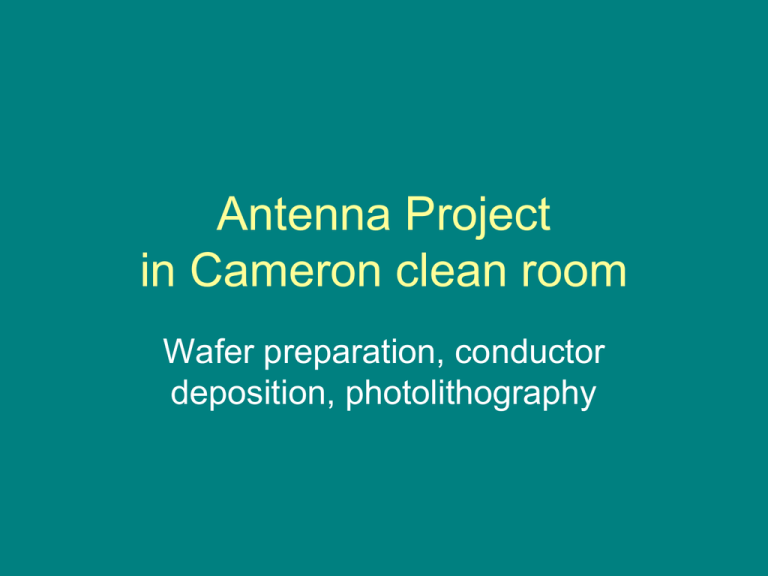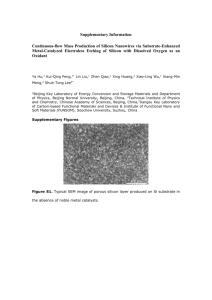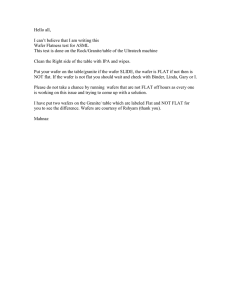Engr 1202 E01 lecture 3 wafer prep and PR revised 1-27-2016
advertisement

Antenna Project in Cameron clean room Wafer preparation, conductor deposition, photolithography Dilbert The starting material for the antenna project is a silicon wafer It is also the starting material for most microelectronic devices Silicon is a group 4 element, meaning it has 4 electrons in its outer electron band Group 4 Why is silicon an excellent microelectronics material? 1. It is very abundant 2. It can be grown into a single orientation crystal 3. It can be made electrically active easily by “doping” with group 3 and group 5 elements 4. It can be made to conduct electrons with a small applied potential 5. It has a naturally forming oxide that acts as an insulating and diffusion barrier Two dimensional schematic of three dimensional crystal Group 3 Elements P type doping – Positive, electron short, also called a hole Group 5 elements N-type doping – N is negative, electron rich Combing n-type silicon and ptype silicon gives a pn junction The whole microelectronics revolution can be traced to this fundamental characteristic of silicon – a semiconductor material Silicon is the most common semiconducting material for today’s microelectronics Many other semiconducting materials like GaAS, and GaN are used for specific applications Creating an antenna on the silicon wafer Starting material is a 100mm (4 inch) wafer of silicon - shown in an edge view Wafers are chemically cleaned first Silicon Dioxide (SiO2 ) is grown on the silicon creating a dielectric or insulating layer The antenna must sit on an insulating layer High temperature tube furnace for the formation of silicon dioxide (SiO2) Once the insulating layer is formed, a conductor needs to be chosen Conductivity of metals 1. Silver • Expensive, used for solar cells 2. Copper • Moderate cost, used in electrical wiring, antennas 3. Gold • Very expensive but very useful in that it will not oxidized. Used in most high quality connections 4. Aluminum • Low cost, easy to use, used for most microelectronics devices For this antenna project Copper will be used A copper metal is vacuum deposited on to the wafer Conductor vacuum deposition tools in the ECE Microelectronics Clean Room Cooke-thermal deposition CHA Mark 50 e-beam deposition CVC 601-sputter deposition Varian 3125 e-beam deposition Photolithography • Photolithography is the transfer of patterns, circuits, device structures, etc. to a substrate or wafer using light and a mask or stencil to stop the light. • Photolithography was used extensively in the progression of microelectronics. • Today, because of the sizes involved in current computer microprocessor devices, other methods like direct patterning using electron beams are used. • Photolithography is still used for dimensions down to about 0.5um. The wavelength of UV light is .35-.45 um. UV light sensitive material called photoresist is spin coated on to the conductor side of the wafer Wafers are spin coated with Shipley 1813 UV sensitive photoresist spin coating produces a uniform coating Spin speed is set here A vacuum chuck holds the wafer Light sensitive material is stored in amber dropper bottles – Use 1813 The antenna design, arrayed on a transparency sheet, is placed on top of the wafer. This transparency is called a photo mask. Production photo masks would be made on glass plates with high precision patterns. The antenna pattern, arrayed and printed on a transparency paper, is used as a photomask The array of antenna will be cut to just larger than the wafer Ultraviolet light is projected down on to the photoresist coated wafer HTG mask aligner and UV light source The UV light source is a mercury vapor lamp at 436nm wavelength Clear glass plates are used to make sure the transparency lays flat to the wafer UV light with filter surrounding it Exposure time set on timer Wafer is held by vacuum, mask is placed on top and brought into contact with wafer The wafer is developed, leaving photoresist where no UV light has penetrated the mask Solitec automatic developer Vacuum switch Start switch Conductors are etched using chemicals specific to the metal Aluminum etch Chrome etch Gold, silver, nickel, and copper etch After etching, the antenna pattern, in the conductor of choice, will be left on the wafer Homework •Complete dimension drawing and printing of transparency mask – submit dimension drawing •Find PowerPoint programs on Mosaic •Begin learning how to use it •Your project report will be done on PowerPoint •Photos of your team working in the clean room are required for the PowerPoint report







